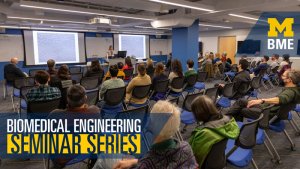Presented By: Biomedical Engineering
Biomedical Engineering Seminar Series
"From seaside to bedside: bioengineering proteins as tools for molecular imaging," with Assaf A. Gilad, PhD

From Seaside to Bedside: Bioengineering Proteins as Tools for Molecular Imaging
Abstract:
Medical imaging has transformed the clinical decision-making process by providing physicians with vital information through MRI, CT, and ultrasound scans. However, despite the benefits of these imaging modalities, there is a critical need to develop new and improved technologies that can monitor changes and abnormalities at the cellular, molecular, and functional levels. Our research lab is at the forefront of the discipline of Molecular Imaging, which is a promising field positioned in the intersection of biomedical research and molecular biology. We focus on creating, implementing, and developing cutting-edge protein engineering techniques to produce genetically encoded tools for Molecular Imaging. In this presentation, we will discuss our latest research findings and their contribution to Molecular Imaging.
We will discuss the development of synthetic and semi-synthetic proteins that can generate contrast through Chemical Exchange Saturation Transfer (CEST)-MRI. We have recently developed new types of proteins that can be efficiently detected through MRI. To achieve this, we designed a novel machine-learning algorithm based on genetic programming, that has allowed us to broaden the search space of peptides that can produce CEST MRI contrast. We have then assembled these peptides into a functional protein that can be used as a reporter to track therapeutic cells and gene delivery vehicles in live systems. We are constantly expanding our arsenal of such reporters by seeking and recombining proteins from various organisms. For example, we are evolving proteins and peptides that bind the lanthanide gadolinium to enhance imaging sensitivity as well as for cleaning medical waste. Another example discussed is a magneto-receptive gene cloned from the glass catfish (Kryptopterus vitreolus). This gene can function as a "biomagnetic switch" and can remotely control the activity of enzymes transduced in cells. Inspired by unique mechanisms found in marine organisms, we aim to develop the next generation of genetically encoded technologies to tackle urgent problems in the biomedical field.
Bio:
Assaf A. Gilad is a Michigan State University Chemical Engineering and Materials Science and Radiology Professor. The overarching theme of his research program is to utilize synthetic biology to develop new biomedical imaging technologies. Specifically, he works to develop novel genetically encoded and nanoparticle biosensors for brain imaging, neuromodulation, and cancer research. He received a B.A. from the Technion, Israel Institute of Technology in Haifa, Israel, and an M.Sc. and Ph.D. in Biology from the Weizmann Institute of Science. He spent three years conducting postdoctoral research in the Department of Radiology at The Johns Hopkins University. In 2007, he joined the Radiology department at The Johns Hopkins University as an Assistant Professor and later as an Associate Professor. In 2017, he moved to Michigan State University.
Zoom:
https://umich.zoom.us/j/94801149707
Abstract:
Medical imaging has transformed the clinical decision-making process by providing physicians with vital information through MRI, CT, and ultrasound scans. However, despite the benefits of these imaging modalities, there is a critical need to develop new and improved technologies that can monitor changes and abnormalities at the cellular, molecular, and functional levels. Our research lab is at the forefront of the discipline of Molecular Imaging, which is a promising field positioned in the intersection of biomedical research and molecular biology. We focus on creating, implementing, and developing cutting-edge protein engineering techniques to produce genetically encoded tools for Molecular Imaging. In this presentation, we will discuss our latest research findings and their contribution to Molecular Imaging.
We will discuss the development of synthetic and semi-synthetic proteins that can generate contrast through Chemical Exchange Saturation Transfer (CEST)-MRI. We have recently developed new types of proteins that can be efficiently detected through MRI. To achieve this, we designed a novel machine-learning algorithm based on genetic programming, that has allowed us to broaden the search space of peptides that can produce CEST MRI contrast. We have then assembled these peptides into a functional protein that can be used as a reporter to track therapeutic cells and gene delivery vehicles in live systems. We are constantly expanding our arsenal of such reporters by seeking and recombining proteins from various organisms. For example, we are evolving proteins and peptides that bind the lanthanide gadolinium to enhance imaging sensitivity as well as for cleaning medical waste. Another example discussed is a magneto-receptive gene cloned from the glass catfish (Kryptopterus vitreolus). This gene can function as a "biomagnetic switch" and can remotely control the activity of enzymes transduced in cells. Inspired by unique mechanisms found in marine organisms, we aim to develop the next generation of genetically encoded technologies to tackle urgent problems in the biomedical field.
Bio:
Assaf A. Gilad is a Michigan State University Chemical Engineering and Materials Science and Radiology Professor. The overarching theme of his research program is to utilize synthetic biology to develop new biomedical imaging technologies. Specifically, he works to develop novel genetically encoded and nanoparticle biosensors for brain imaging, neuromodulation, and cancer research. He received a B.A. from the Technion, Israel Institute of Technology in Haifa, Israel, and an M.Sc. and Ph.D. in Biology from the Weizmann Institute of Science. He spent three years conducting postdoctoral research in the Department of Radiology at The Johns Hopkins University. In 2007, he joined the Radiology department at The Johns Hopkins University as an Assistant Professor and later as an Associate Professor. In 2017, he moved to Michigan State University.
Zoom:
https://umich.zoom.us/j/94801149707